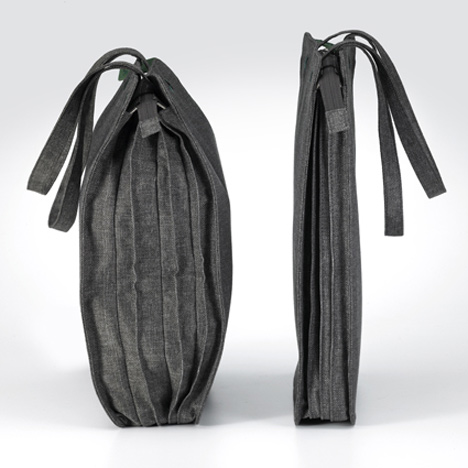
Designer Benjamin Hubert has created this laptop bag which expands to become an overnight bag, in collaboration with Nava.
 SAYL Chair at a Herman Miller 1952 desk model 4658. Image Credit Emma Alter
Office chairs are a difficult design problem. Herman Miller's classic Aeron chair has been a hit for over a decade, but it costs nearly a thousand bucks and is rarely seen outside of high end offices, although it was the darling perq of internet startups; there were even Aeron hockey tournaments. At the other end of the scale, crowding the aisles of Staples and Walmart, are the usual low end home office chair that had perhaps a height adjustment but not much else, that sell for well less than a tent... Read the full story on TreeHugger
SAYL Chair at a Herman Miller 1952 desk model 4658. Image Credit Emma Alter
Office chairs are a difficult design problem. Herman Miller's classic Aeron chair has been a hit for over a decade, but it costs nearly a thousand bucks and is rarely seen outside of high end offices, although it was the darling perq of internet startups; there were even Aeron hockey tournaments. At the other end of the scale, crowding the aisles of Staples and Walmart, are the usual low end home office chair that had perhaps a height adjustment but not much else, that sell for well less than a tent... Read the full story on TreeHugger
“But interesting is that 1000$ spend on a chair is much less CO2 emitting than 1000$ spend on an flight, holiday. To decouple economy, rising population and income from the environment we need more environmental products that people like to spend more mone”

This Solar Powered LED Flower Light can add a touch of fantasy to any garden or outdoor area. The flower heads each contain a LED to provide illumination, giving them a gentle beautiful glow.
The Solar Powered LED Flower Light can be used to provide a talking point for your outdoor areas, either by placing the device in a clearly seen area as a feature or putting it somewhere more hidden to add a surprise to anyone wandering your garden. Each of the 3 flower heads contains its own LED to provide illumination, creating a warm and attractive glowing flower head.
The flower light uses solar power to provide the energy to light the LED’s, this energy is stored in the internal 600mA NI-CD storage battery. When the battery has been fully charged it can provide you with over 8 hours of illumination from the lights. Some thought must be given when placing the light to ensure that the solar panel receives enough sunlight to charge the battery so that the LED’s can provide you with a beautiful lighting effect throughout the night.
The Solar Powered LED Flower Light can provide a fantastical touch to any outdoor area. Due to the use of solar energy as a power source the light is easy to install and requires no complicated wiring nor will it incur any long term running costs.
The Solar Powered LED Flower Light is just £23.67 plus delivery.
Want to buy this gadget? Check out the Solar Powered LED Flower Light article on EnviroGadget to see the lowest prices for this gadget.
© 2008 to 2011 EnviroGadget.com. You can now keep up with the latest eco-gadgets on the EnviroGadget Facebook page. Why not help us to spread the word?
Related posts:

Try arranging them in different possible ways and use them for different possible purposes! Yes, B-Squares, the new portable solar energy gadgets, available from 1st May 2011 in the market, have such features. The 3D modular energy storage devices flaunt surface microsuction with magnetic properties added. They are Arduino compatible and portable. They work using magnetic and electric contacts on each corner.
The squares snap together for arrangement in an order. These arrangements bring changes in electric circuit. One can stack the squares as well. When LED-Square, Solar-square and Battery-square are connected, solar lantern would glow. When five solar-squares and a Battery-square are connected flat, it results into an energy storage custom solar panel.
Solarduino can be made using Arduino, Solar and Battery squares. Two solar and LED, One Arduino and Battery squares are connected for an optimus prime. One iPhone square can be used as a iPhone Dock; iPhone and battery squares can be connected for an iPhone charger; and to this a speaker square is connected for iPhone radio.
The best word to describe them probably would be versatile! This new collection of 3D modular energy storage devices are developed by Jordan McRae and Shawn Frayne. The MIT grads made a complete recipe book of different configurations available for the user. Not much information is available about pricing of the product yet; however, price would not be a matter if the device combination can be an alternate source of power or back-up. One would not mind if regular power goes while watching ones favorite television program!
The following video gives more information on the permutations and combinations for a desired device order. Watch it and start applying the order combinations for multiplied fun!
Via: Engadget

Compressed air energy storage (CAES), according to researchers is the latest technology in conserving intermittent energy. Intermittent energy is any energy source (e.g. the wind or a tidal wave) that though predictable is beyond human control and cannot be harnessed at will. Researchers are increasingly talking about using compressed air energy storage systems. This technology envisages a situation where intermittent energy can be stored on a very large scale and released as and when required. The greatest glitch in storing this kind of energy is that unless electrical energy is converted into another form it cannot be stored. This causes tremendous efficiency losses and is not an economically viable solution.

The basic premise on which the CAES works is that excess power on the grid powers an electric motor to drive a compressor. The product is compressed air. The temperature of this compressed air is brought down and then is stored at pressures of 60 to 70 bar. Researchers admit that the concept is not new and that CAES plants have been functioning in Germany and Alabama since 1978 and 1991 respectively. But these plants use a large amount of carbon-based fuels to restore the high temperatures so that the stored compressed air can be expanded in a gas turbine. As a result both these plants record high levels of efficiency losses in the form of heat.

Researchers worldwide are exploring the possibility of storing the heat generated when the compressors are working. The objective is to use this to rewarm the air when required. This is known as Advanced Adiabatic CAES or AA-CAES. A major problem faced by technologists is that when the air is compressed to 60 – 70 times atmospheric pressure, the heat energy generated can go up to 650 degrees and becomes difficult to manage.
Prof of Dynamics, Seamus Garvey at the Nottingham University has proposed a cost effective CAES system. According to him, Energy Bags with butyl rubber bladders and outer surfaces made of polyester-reinforced fabric coated with steel straps are the perfect solution to the problem. These bags can be stored underwater as the sea acts as the pressure machine.
As technologists worldwide are gearing up to work on AA-CAES, it remains to be seen whether this innovative solution will finally be able to resolve the problems of intermittent energy conservation in the long run.

Via: The Engineer
Gypsy Modular is a new line of furniture made from modular components so it can be configured and then reconfigured based on your needs. Connectors built directly into the parts hold together with friction and pressure, so there is no need for tools or hardware. The components are made from MDF (while we usually shun medium density fiberboard, Gypsy does point out that most MDF is made from recycled pre-consumer content and is significantly stronger than other particle boards) or Baltic Birch Ply and can be assembled in seconds, so it’s great for kids as well as students and those on the move.
Permalink |
Add to
del.icio.us |
digg
Post tags: "green furniture", "sustainable furniture", eco furniture, flat pack furniture, green design, gypsy modular, modular furniture, sustainable design
 Herman Miller has won a 2011 Social Innovation award for making substantial gains in reducing its CO2 footprint, while maintaining a strong financial performance over the past year.
Herman Miller has won a 2011 Social Innovation award for making substantial gains in reducing its CO2 footprint, while maintaining a strong financial performance over the past year.

What’s happening right now?
Wind power has already made its way into the pantheon of renewable energy sources as it’s clearly exhibited by the following numbers, which says that by the end of July, 2010, worldwide nameplate capacity of wind-powered generators was 175 GW. Now compare this to total capacity in the year 2000, which was only 17.4 GW. Energy production was 340 TWh by 2010, which is about 2 percent of worldwide electricity usage and has doubled in the past three years. Well, this is all well and good, except for the fact that electricity generated from wind power can be highly variable at several different timescales: from hour to hour, daily, and even seasonally. In response to this type of variation, now we are looking forth to integrate systems that can harness winds at much higher altitudes.
Trends:
1. MARS – A wind turbine that is up in air

At the first instance, it may look like a giant blimp, but in actuality MARS (Magenn Air Rotor System) is a lighter-than-air tethered wind turbine that rotates about a horizontal axis in response to wind, generating clean electrical energy. The inflated system uses a three dimensional structure (unlike the two dimensional blades of conventional turbines) kept afloat in the air by helium. The mechanism can harness winds at a level of 600 ft to 1000ft and even nocturnal jet streams, while the resultant energy captured is transferred down to earth by 1000ft long tether cables.
2. Joby Energy tests high-altitude wind turbine prototype

A prototype by Joby Energy epitomizes innovation at its best. Basically a flying platform with an array of wind propellers (much like an aircraft without cockpit), the propellers lift up the contraption to a certain level, and once steadily deployed in the air, the whole system moves in rapid circular motion. This motion pattern maximizes the face exposure to wind streams, thus allowing it to collect the energy and transmitting it back to the surface by use of cables. The system has a capacity of 30 KW, but if successful, the company could even manufacture a 100 KW version.
3. Energy starved New York could soon get powered by jet stream winds

Jet streams can be described as fast flowing, narrow air currents found in the atmospheres of some planets, including Earth. Now researchers from Carnegie Institution and California State University have identified New York City as one of those locations that have the potential to immensely benefit from harnessing energy from jet streams. Basically the system calls for energy harnessing kites to be flown high up at an altitude of more than 30,000 ft, where they can transfer the collected energy from the existing jet streams back to the earth by their tethered cables. If the system works successfully, then according to the scientists it can produce ten times more energy as conventional wind turbines, with more than 400 MW of electricity generation.
4. Kite farm offers parasailing while producing energy for the adventurous sort

Imagine you are parasailing over the deep blue sea, with your adrenaline pumping high and the glorious wind waving at your visage, but on a different system, the whole world is benefiting from your little tryst with adventure. Now that would be good feeling, and that is exactly what Colombian landscape architecture studio Paisajes Emergentes plans on doing. The proposition calls for an energy generating kite farm, on a public beach, in Abu Dhabi, under the Land Art Generator Initiative. There would be around 200 kites tethered across a 60-meter grid of flexible posts, and with an advanced wind belt generator, each of them (the kites) can produce roughly 6,200 kilowatt-hours a year, which is enough to power three energy-efficient homes. So in a modest estimate, this innovative ‘adventure’ wind farm can power around 600 homes!
5. Makani Power to develop energy harvesting kites

California-based high altitude wind company Makani Power wants to develop a 1MW prototype of an energy-harvesting kite, which can be flown at high altitudes of more than 600 m (20,000 ft). Such kites can make use of steadier wind velocities to generate more power than conventional wind turbines. Moreover, to add to that ’sci-fi’ flavor, robots will fly these kites while enabling them to keep afloat for a longer period.
6. NASA researchers envisions airborne wind turbines for renewable energy

In NASA’s reverie, wind turbines would not take up earth’s spaces, but rather ‘float’ in the free space above earth. NASA aerospace engineer Mark Moore believes that the idea in itself has great potential, as wind speed is more consistent and its velocity much higher and steadier at higher altitudes. The resultant energy can be transmitted back to earth via nanotube cables.
The concept:
We have already talked about the variations in magnitude of wind energy that we can come across while harnessing it at surface level. In order to counter these variations, many ingeniously conceived technologies look forth to incorporate mechanisms that can harness winds at higher altitudes, as wind at this height becomes steadier, more persistent, and of higher velocity. Moreover, theoretically the power available in wind increases according to the cube of velocity (the velocity-cubed law), hence assuming other parameters remaining the same, doubling a wind’s velocity gives us 2×2x2=8 times the power (or thrice velocity gives us 27 times the power). Known as high altitude wind power (HAWP), the mechanisms involve capturing the power of winds high in the sky and transmitting it back to earth surface by use of tether and cable technology.
The advantages:
We already know that the wind energy generated at high altitudes can be multiple times the magnitude of the energy generated at ground level. However, other than that, such technologies would totally forego the usage of comparatively costly, cumbersome and easily damageable ground wind turbines. That in effect would also nullify the adverse conditions of noise pollution and even the visual burden on natural landscaping, all of which are generally associated with conventional wind turbines.
The impact:
Statistically, we have already seen the rise of the capacity of wind power by 10 times in the last 10 years. Now considering HAWP technologies are still at their nascent stage, and given their enormous potential, we certainly have a great chance to witness an exponential increase in wind power output, once the system advances beyond its present state. Like California-based HAWP company, Makani Power believes that capturing a small fraction of the global high altitude wind energy would be sufficient to power the entire planet!

California State Assembly’s Natural Resources Committee has approved a bill for a pilot project that will enable Californian highways to produce green power for thousands of households. While vehicular traffic is mostly seen as a menace, the same can be used to provide renewable energy, if the highways are stuffed with piezoelectric devices that generate power using vibrations produced when cars, trains or people move across the surface.
Researchers believe that a 6-mile stretch of roadway embedded with piezoelectric generators could produce up to 44MW of renewable electric power, which is enough to power 30,800 homes. The best part about the project is that peak energy demands will coincide with rush hour, which will help generate more energy. The technology has already been tested by Israeli company Innowattech and the sensors needed for such an installation are inexpensive, which can help generate renewable energy at a reduced cost.
Via: CNet




Comments by our Users
Be the first to write a comment for this item.